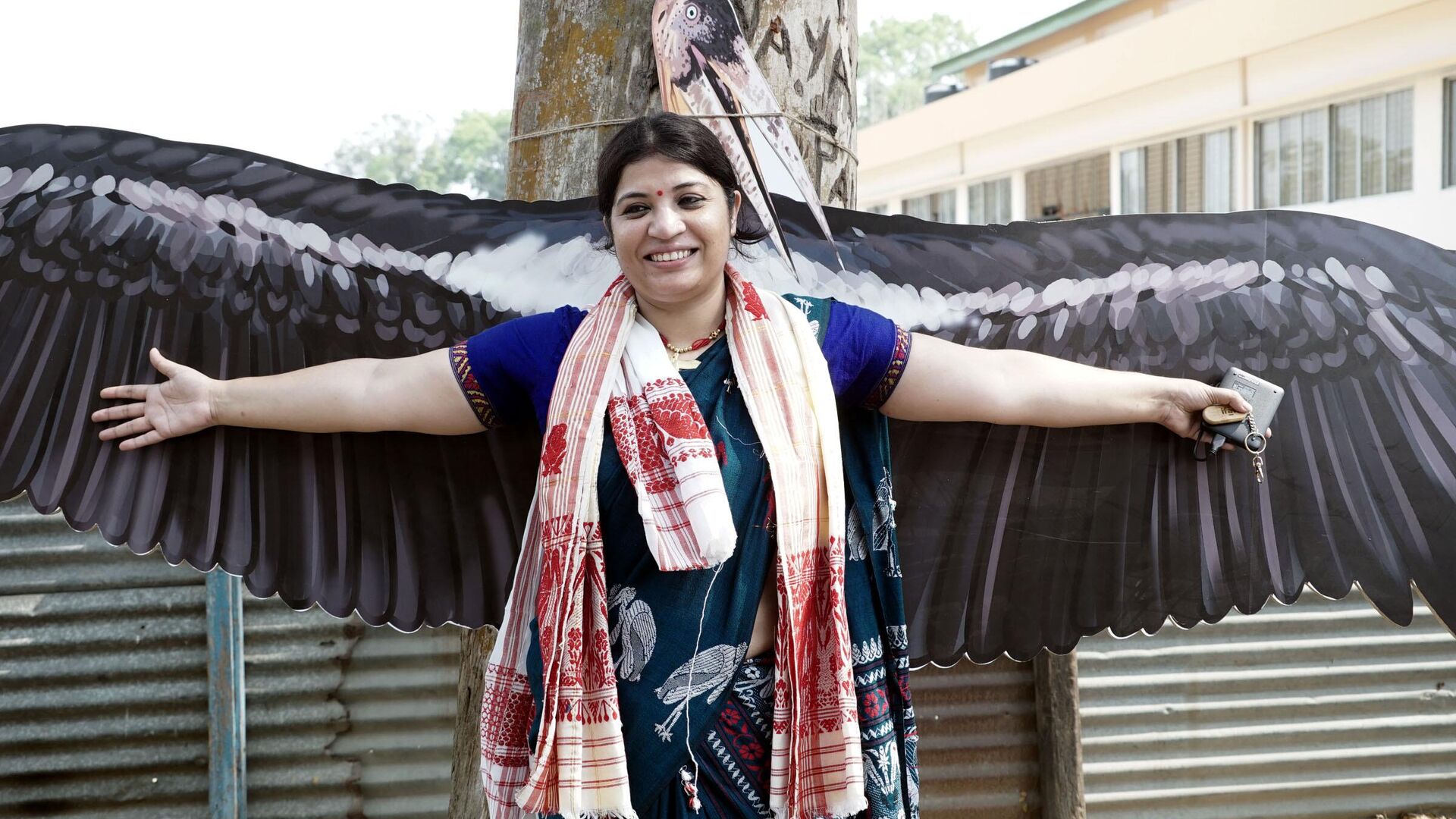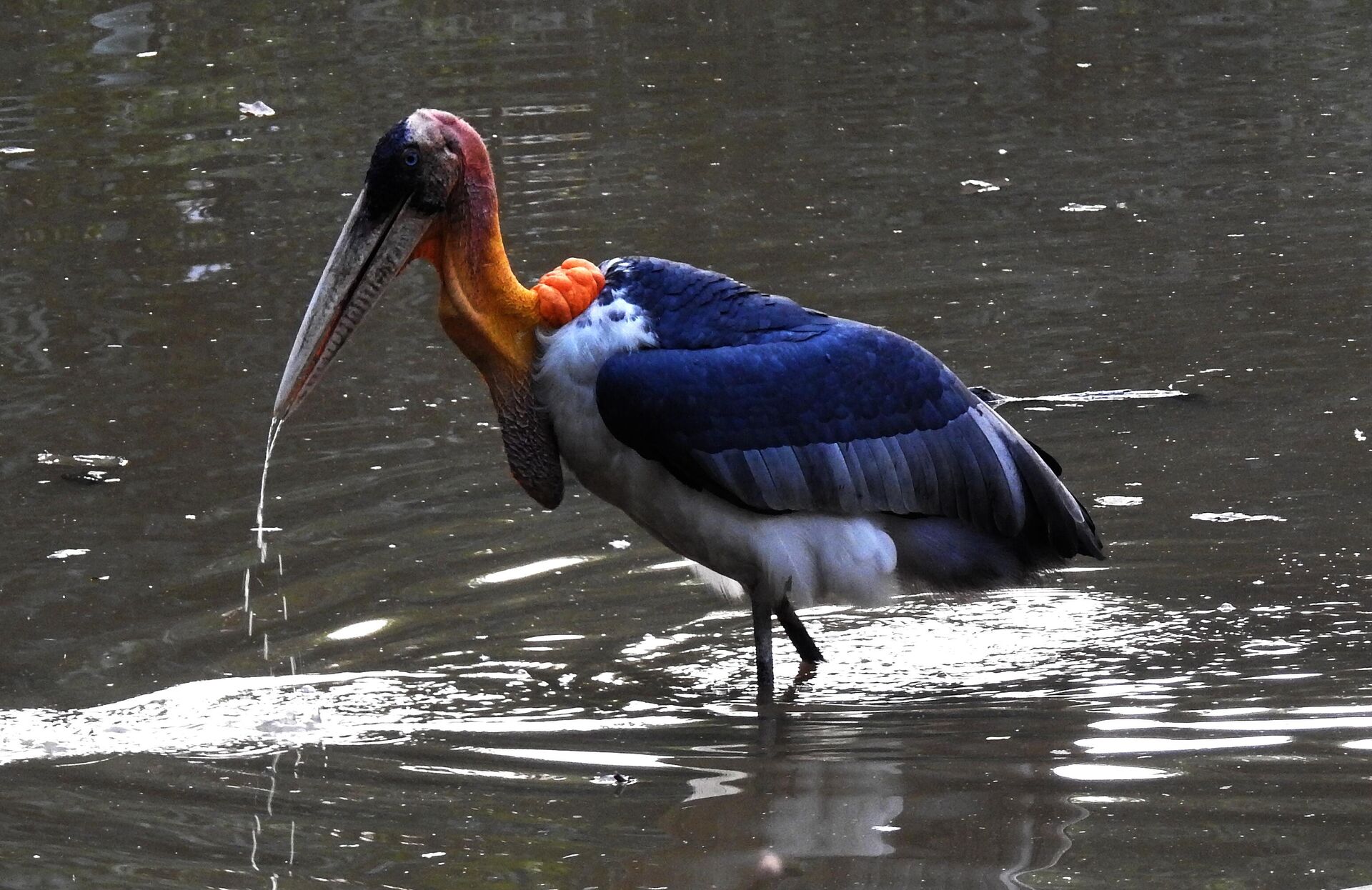https://sputniknews.in/20230304/from-nature-lover-to-hargila-army-founder-how-biologist-became-adjutant-stork-conservationist-1067287.html
From Nature Lover to Hargila Army Founder: How Biologist Became Adjutant Stork Conservationist
From Nature Lover to Hargila Army Founder: How Biologist Became Adjutant Stork Conservationist
Sputnik India
One of the world's rarest adjutant stork birds, also known as Hargila (the bone swallower), was once considered a “bad omen”, “scavenger,” “disease carrier” and “ugly” by the villagers in Assam who would destroy their nests.
2023-03-04T11:02+0530
2023-03-04T11:02+0530
2023-03-22T19:27+0530
india
wildlife
environment
nature conservation
sputnik exclusives
https://cdn1.img.sputniknews.in/img/07e7/03/03/1067920_0:84:2400:1434_1920x0_80_0_0_5adb26a93ed93d0673a52aa2334b5e71.jpg
Dr Purnima Devi Barman, a 43-year-old Indian wildlife biologist, has not only striven to protect the endangered greater adjutant stork and change the opinion of villagers in India’s Assam state, but has also had her efforts recognized far further afield.Barman, who won the UN Environment Champions of the Earth Award in 2022, has formed the Hargila Army - an all-women group of volunteers from several villages in Assam - with whom she has been able not just to save adjutant storks and preserve their habitat but also make the bird an integral part of their culture.The greater adjutant stork which grows to 5ft and has a massive bill and neck pouch is hard to ignore with its distinctive look and features.Childhood Impacting Her LifeBarman’s love of animals started at the early age of five when she was living with her grandparents on the banks of the Brahmaputra River, where she often encountered all sorts of species of birds coming to the paddy fields and wetlands.She would look forward to going to the paddy field with her grandmother where they would discuss the names of the birds they would watch there. “She would also sing a song about egrets [a type of heron] and tell fables,” Barman recalled.Little did she know that she would one day be working on the conservation of endangered birds as a wildlife biologist.“While growing up, my biggest learning was about co-existing with wildlife. My grandma was not at all educated, but she taught me how to be as kind as nature is, and that had a deep impact on my life,” Barman said.Decline of the Greater Adjutant StorkOver the years, the population of adjutant storks started to decline and the sighting of the bird had become a rare event in India.So much so that the International Union for Conservation of Nature (IUCN) has listed the greater adjutant stork in its Red List of Threatened Species and called it the second-rarest stork species in the world.According to data from the IUCN, the population of greater adjutant storks, which is restricted to India’s Assam and Bihar states, and Cambodia, is estimated to be between 800 and 1,200.Barman told Sputnik that a big reason for the species' decline is because its natural habitat is being destroyed.“The greater adjutant stork is so huge that they breed atop bamboo trees and others. But there was a big misconception and taboo among villagers who would consider them unhygienic and disease carriers as they are scavengers and feed on carcasses and garbage dumps. Therefore, they would cut the nest-trees and didn’t allow the bird to breed in their locality,” Barman explained, adding that other reasons for the decline are deforestation, pollution, and depletion of the wetlands.Recalling one of the moments that changed her life, Barman said that while she was doing her PhD thesis on the greater adjutant stork, she got a call from a villager who had a bird and its chicks which had been left to die after he had cut down the tree where they were nesting.When she started to communicate with the villager and his neighbors, she was shouted at and mocked by them.“The villager who had cut the tree was so angry at me for saving the ones who were alive. One of his neighbors said that 'this is a scavenger bird. It is filthy, messy and unhygienic, and a bad omen. We cannot keep it in our backyard. It makes our area very dirty and smelly'.“Another neighbor mocked me and said, ‘I too have a nest tree of storks. If you love them so much, why don’t you come and become the cleaner at our place’. Somebody said that 'this lady has come to eat the meat of the stork',” Barman recalled.While returning home, she kept thinking about how to change the way people thought about the bird so that they would stop their cruelty and destroying their habitat.She became all the more determined in her mission to conserve the stork and its habitat.She went to the village again the next day along with her two daughters and met the same villager.“With folded hands, I addressed him as brother and said that these birds too are living creatures like humans and they have their own space to live and have a family like us. All we can do is just try to co-exist with them peacefully instead of bring brutal to them,” Barman said, adding that his views changed, and he joined her in protecting the birds.“After that incident, I experienced the power of the community and decided to make use of it for stork conservation,” Barman added.She then started the Hargila Army of villagers, especially the network of thousands of families across villages who travel door to door with her in spreading awareness and educating people about stork conversation.But it hasn't been easy to convince people to come out of their home and volunteer in this work.“Initially women hesitated to come out and volunteer - or even change their perception about storks. But one day, I organized a cooking contest and scores of people participated and that’s how all our gatherings revolved around stork conservation and restoring their ecosystem. Slowly and gradually, we increased the network, and now we are saving many other endangered species, rescuing animals in distress, and more,” Barman said.“It is joy and learning that has driven me in this work and I strongly feel that if you are persistent and consistent, you will be able to achieve success one day,” she concluded.
india
Sputnik India
feedback.hindi@sputniknews.com
+74956456601
MIA „Rossiya Segodnya“
2023
Sangeeta Yadav
https://cdn1.img.sputniknews.in/img/07e6/0c/0f/110602_0:0:641:640_100x100_80_0_0_c298016a79eb02ef8caa9d1f688c12a5.jpg
Sangeeta Yadav
https://cdn1.img.sputniknews.in/img/07e6/0c/0f/110602_0:0:641:640_100x100_80_0_0_c298016a79eb02ef8caa9d1f688c12a5.jpg
News
en_IN
Sputnik India
feedback.hindi@sputniknews.com
+74956456601
MIA „Rossiya Segodnya“
Sputnik India
feedback.hindi@sputniknews.com
+74956456601
MIA „Rossiya Segodnya“
Sangeeta Yadav
https://cdn1.img.sputniknews.in/img/07e6/0c/0f/110602_0:0:641:640_100x100_80_0_0_c298016a79eb02ef8caa9d1f688c12a5.jpg
indian wildlife biologist, dr. purnima devi barman, conservation of the endangered adjutant stork bird, un environment champions of the earth award, awardee, dr. barman, hargila army, women volunteers,
indian wildlife biologist, dr. purnima devi barman, conservation of the endangered adjutant stork bird, un environment champions of the earth award, awardee, dr. barman, hargila army, women volunteers,
From Nature Lover to Hargila Army Founder: How Biologist Became Adjutant Stork Conservationist
11:02 04.03.2023 (Updated: 19:27 22.03.2023) One of the world's rarest birds, the greater adjutant stork, known locally as the Hargila (bone swallower), was once considered a “bad omen”, “scavenger”, “disease carrier” and “ugly” by the villagers in Assam who would destroy their nests.
Dr Purnima Devi Barman, a 43-year-old Indian wildlife biologist, has not only striven to protect the endangered greater adjutant stork and change the opinion of villagers in India’s Assam state, but has also had her efforts recognized far further afield.
Barman, who won the UN Environment Champions of the Earth Award in 2022, has formed the Hargila Army - an all-women group of volunteers from several villages in Assam - with whom she has been able not just to save adjutant storks and preserve their habitat but also make the bird an integral part of their culture.
“From weaving motifs of storks on their ‘mekhela chador’ [a traditional Assamese sarong], to composing different folk songs, dance steps based on birds and holding events and competitions to educate people about the stork, the Hargila Army is involving every family in several villages to join the movement of conserving and preserving the ecosystem of storks,” Barman told Sputnik.
The greater adjutant stork which grows to 5ft and has a massive bill and neck pouch is hard to ignore with its distinctive look and features.
Childhood Impacting Her Life
Barman’s love of animals started at the early age of five when she was living with her grandparents on the banks of the Brahmaputra River, where she often encountered all sorts of species of birds coming to the paddy fields and wetlands.
“My father was a soldier, and he was on a transferable job so I was staying with my grandparents who were farmers. I used to feel the vacuum as my parents were away but my grandma filled that by connecting me with nature,” Barman said.
She would look forward to going to the paddy field with her grandmother where they would discuss the names of the birds they would watch there. “She would also sing a song about egrets [a type of heron] and tell fables,” Barman recalled.
Little did she know that she would one day be working on the conservation of endangered birds as a wildlife biologist.
“While growing up, my biggest learning was about co-existing with wildlife. My grandma was not at all educated, but she taught me how to be as kind as nature is, and that had a deep impact on my life,” Barman said.
Decline of the Greater Adjutant Stork
Over the years, the population of adjutant storks started to decline and the sighting of the bird had become a rare event in India.
So much so that the International Union for Conservation of Nature (IUCN) has listed the greater adjutant stork in its Red List of Threatened Species and called it the second-rarest stork species in the world.
According to data from the IUCN, the population of greater adjutant storks, which is restricted to India’s Assam and Bihar states, and Cambodia, is estimated to be between 800 and 1,200.
Barman told Sputnik that a big reason for the species' decline is because its natural habitat is being destroyed.
“The greater adjutant stork is so huge that they breed atop bamboo trees and others. But there was a big misconception and taboo among villagers who would consider them unhygienic and disease carriers as they are scavengers and feed on carcasses and garbage dumps. Therefore, they would cut the nest-trees and didn’t allow the bird to breed in their locality,” Barman explained, adding that other reasons for the decline are deforestation, pollution, and depletion of the wetlands.
Recalling one of the moments that changed her life, Barman said that while she was doing her PhD thesis on the greater adjutant stork, she got a call from a villager who had a bird and its chicks which had been left to die after he had cut down the tree where they were nesting.
“I met a villager in Dardara Village in the Kampur district of Assam, where he had cut the nest-tree of adjutant storks and nine chicks that fell down. A few died and a few were alive. My heart broke to witness their plight,” Barman said.
When she started to communicate with the villager and his neighbors, she was shouted at and mocked by them.
“The villager who had cut the tree was so angry at me for saving the ones who were alive. One of his neighbors said that 'this is a scavenger bird. It is filthy, messy and unhygienic, and a bad omen. We cannot keep it in our backyard. It makes our area very dirty and smelly'.
“Another neighbor mocked me and said, ‘I too have a nest tree of storks. If you love them so much, why don’t you come and become the cleaner at our place’. Somebody said that 'this lady has come to eat the meat of the stork',” Barman recalled.
While returning home, she kept thinking about how to change the way people thought about the bird so that they would stop their cruelty and destroying their habitat.
She became all the more determined in her mission to conserve the stork and its habitat.
She went to the village again the next day along with her two daughters and met the same villager.
“With folded hands, I addressed him as brother and said that these birds too are living creatures like humans and they have their own space to live and have a family like us. All we can do is just try to co-exist with them peacefully instead of bring brutal to them,” Barman said, adding that his views changed, and he joined her in protecting the birds.
“After that incident, I experienced the power of the community and decided to make use of it for stork conservation,” Barman added.
She then started the Hargila Army of villagers, especially the network of thousands of families across villages who travel door to door with her in spreading awareness and educating people about stork conversation.
But it hasn't been easy to convince people to come out of their home and volunteer in this work.
“Initially women hesitated to come out and volunteer - or even change their perception about storks. But one day, I organized a cooking contest and scores of people participated and that’s how all our gatherings revolved around stork conservation and restoring their ecosystem. Slowly and gradually, we increased the network, and now we are saving many other endangered species, rescuing animals in distress, and more,” Barman said.
“It is joy and learning that has driven me in this work and I strongly feel that if you are persistent and consistent, you will be able to achieve success one day,” she concluded.



